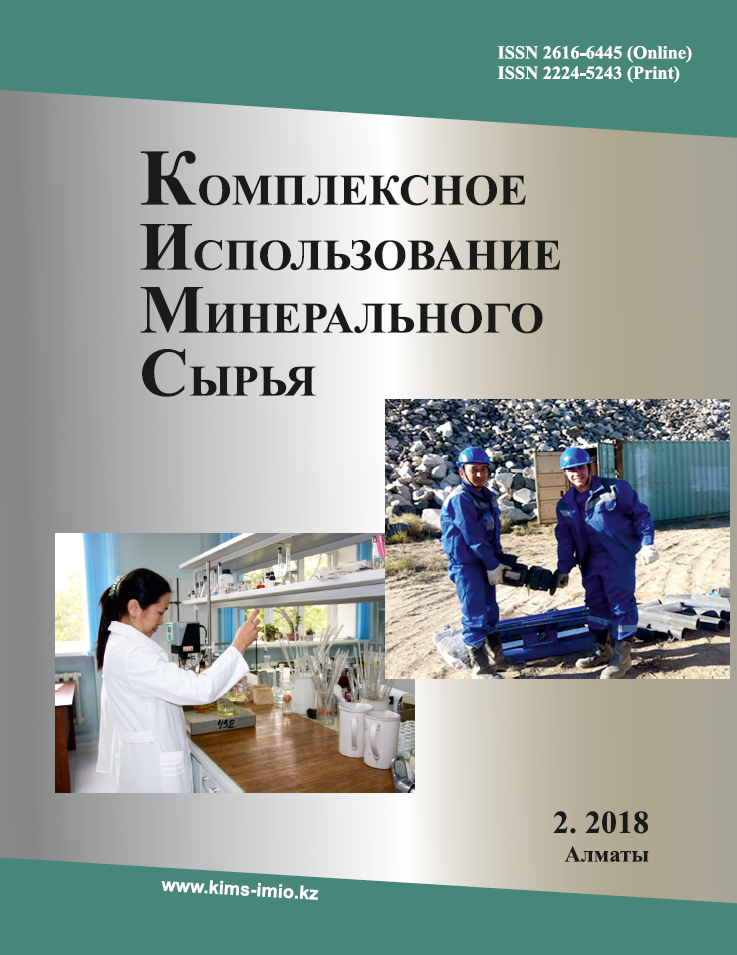The study the possibility of using waste from wine-alcogol production of by the selective separation of collective copper-lead concentrate
DOI:
https://doi.org/10.31643/2018/6445.3Keywords:
alcohol production waste, sodium sulfite, ferrous sulfate, selective flotation, collective concentrate.Abstract
Currently one of the priority objectives in the field of flotation retreatment of complex ores are exploration and the development of effective and selective chemical reagents in order to increase an extraction of valuable components and expenses reduction per output unit. Practical experience of flotation shows that the process diagrams of receiving a collective concentrate of non-ferrous metals with their further selective separation to obtain a lead, copper, zinc concentrate are applied to extract the non-ferrous metals concentrates out of complex ores. The efficiency of selective separation of collective concentrates depends on the range of flotation reagents in many respects. The paper includes the studies of a collective copper-lead concentrate applicability of alcohol waste from «Bacchus» JSC under selective separation. A liquid waste compound was studied for the purpose and sulfite ions content was established that allows replacing sodium sulfite at selective separation of copper and lead by sulfite technology.A complex ore of Artemjevsky deposit was used as an initial matter at the selective flotation separation; the ore contains copper 1.6%, lead 2.6%, zinc, 7.2%, iron 7.8%. The flotation circuit includes a copper-lead cycle with the receiving of a collective copper-lead concentrate and a selection cycle for collective copper-lead concentrate. The waste is used instead of sodium sulfite in the cycle of selection of collective copper-lead concentrate. The liquid waste of alcohol production allows replacing the basic reagent sodium sulfite, at simultaneous keeping of technological parameters of floatation enrichment and contributes expenses reduction for complex raw materials retreatment.
Downloads
References
Pol'kin S. I., Adamov EH. V. Obogashchenie rud cvetnykh metallov (Beneficiation of non-ferrous met-als). Moskow: Nedra. 1983, 400. (in Russ.).
Kosherbaev K. T. Tekhnologiya selektivnoj flo-tatsii mineralov iz kollektivnykh sul'fidnykh kontsentra-tov: Trudy KazPTI (Technology of the selection flotation of minerals from collective sulphidic concentrates: Works of the polytechnical Institute). vyp. Metallurgiya i metallovedenie (release 2, Metallurgy and metallurgical science). Almaty, Kazakhstan, 1975. 114–119. (in Russ.).
Bakinov K. G. Issledovanie ustojchivosti sistemy Fe2+-SO2-3, primenyaemyj dlya selektsii sul'fidov (Research of stability of the Fe2+-SO2-3 system, applied to selection of sulfides). Tsvetnye metally = Non-ferrous metals. 1974. 7, 93– 96 (in Russ.).
Vidueckij M.G., Korableva L.V., Stavskij G.G. K voprosu razdeleniya medno-svintsovykh kontsentratov (Separation of copper-lead concentrates). Gornyj infor- macionno-analiticheskij byulleten' (nauchno-tekhnicheskij zhurnal) = Mining informational and analytical Bulletin (scientific and technical journal). 2009. 15. 12. 294–300. (in Russ.).
Kochin V. A., Nabojchenko S. S., Lebed' A. B., Mal'tsev G.I. Avtoklavno-flotatsionnaya skhema pererabotki Cu–Pb–Zn kontsentratov (Pressure leaching–flotation method processing Cu–Pb–Zn concentrates). Sovremennye problemy nauki i obrazovaniya (Modern problems of science and education). 2013. 2. [Ehlek-tronnyj resurs] URL: http://www.scienceeducation.ru/108-8940. (in Russ.).
Pandhe G, Suyantaraa W., Hirajimaa T., Mikia H., Sasa- kia K., Yamaneb M., Takidab E., Kuroiwab S.Y. Imaizumi Selective flotation of chalcopyrite and molybdenite using H2O2 oxidation method with the addition of ferrous sulfate. Minerals Engineering. 2018. 122. 312–326. (in Eng).
M. Li, D. Wei, Q. Liu, W. Liu, J. Zheng, H. Sun Flotation separation of copper–molybdenum sulfides using chitosan as a selective depressant. Minerals Engineering. 2015. 83, 217–222. (in Eng).
Z. Cao, X. Chen, Y. Peng. The role of sodium sulfide in the flotation of pyrite depressed in chalcopyrite flotation. Minerals Engineering. 2018. 119. 93–98. (in Eng).
J. Li, K. Song, D. Liu, X. Zhang, S. Wen Hydro-lyzation and adsorption behaviors of SPH and SCT used as combined depressants in the selective flotation of galena from sphalerite. Journal of Molecular Liquids. 2017. 231. 485–490. (in Eng).
B. Vasanthakumar, H. Ravishankar, S. Subramanian Selective bio-flotation of sphalerite from galena using mineral – adapted strains of Bacillus subtilis. Minerals Engineering. 2017. 110. 179–184.
Tusupbaev N. K., Kalugin S. N., Tusupbaev S. N., Semushkina L. V., Turysbekov D. K., Mukhanova A. A., Mukhamedilova A. M. Primenenie modifitsirovannykh reagentov dlya usovershenstvovaniya tekhnologii flotatsionnogo obogashcheniya tonkovkraplennykh polimetallicheskikh rud (Use of the modified reagents for improvement of technology of floatation enrichment the thin-grained polimetalic ores). Kompleksnoe ispol’zovanie mineral’nogo syr’ya = Complex use of mineral resources. 2013. 4, 19–24 (in Russ.).
Efremova S. V., Bunchuk L. V., Li EH. M., Niyazov A. A., Suharnikov YU. I. Polupromyshlennye ispytaniya flotoreagenta iz risovoj shelukhi v kachestve sobiratelya (The semi-production tests of a flotation agent from a rice peel as the collector). Kompleksnoe ispol’zovanie mineral’nogo syr’ya = Complex use of mineral resources. 2017. 4, 5–11 (in Russ.).
Tusupbaev N. K., Bekturganov N. S., Turysbekov D. K., Semushkina L. V., Muhanova A. A. Usovershenstvovanie tekhnologii selektsii kollektivnogo medno-svintsovo-tsinkovogo kontsentrata (Improvement of technology of selection of a collective copper-zinc-lead concentrate). Obogashchenie rud = Ore benefica-tion. 2013. 6, 12–17. (in Russ.).
B. Guo, Y. Peng, R. Espinosa-Gomez. Cyanide chemistry and its effect on mineral flotation. // Minerals Engineering. 2014. 66-68. 25–32. (in Eng).
Nikolaev A. A., So Tu, Goryachev B. E. Kriterij selektivnosti dejstviya sobiratelya v kollektivno-selektivnykh tsiklakh flotatsii sul'fidnykh rud (Criterion of collector's selectivity in sulfide ores bulk-selective flotation circuits). Obogashchenie rud = Ore beneficiation. 2016. 4, 23–28. DOI 10.17580/or.2016.04.04. (in Russ.).
Ignatkina V. A., Bocharov V. A., Milovich F. O., Ivanova P. G., Hachatryan L. S. Selektivnoe pov-yshenie flotoaktivnosti sul'fidnykh tsvetnykh metallov s ispol'zovaniem sochetanij sul'fgidril'nykh sobiratelej (The selection increase in floatation activity of sulphidic nonferrous metals with use of combinations of sulfhy-dryl collectors). Obogashchenie rud = Ore beneficiation. 2015. 3, 18–23. (in Russ.). https://doi.org/10.17580/or.2015.03.03
Jiang M.G., Liu Q.J., Xiao H., Yang J.L. Re-search on Separation of Copper-Lead Mixed Concentrate. Advanced Materials Research. 2012. 581–582. 1096–1101. (in Eng).
Glazunov L.A.. Tomova I.S. Osobennosti obogashcheniya polimetallicheskikh rud Yaponii (Features of enrichment of polymetallic ores of Japan).- M.: Tsvetmetinformatsiya. 1976. 57. (in Russ.).
Downloads
Published
How to Cite
Issue
Section
License
Copyright (c) 2022 Syemushkina, L., Narbekova, S., Mukhanova, А., & Kaldybayeva, Z.

This work is licensed under a Creative Commons Attribution-NonCommercial-NoDerivatives 3.0 Unported License.


























